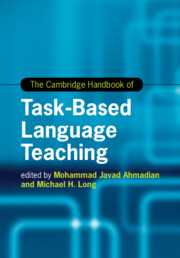Book contents
- The Cambridge Handbook of Task-Based Language Teaching
- Cambridge Handbooks In Language And Linguistics
- The Cambridge Handbook of Task-Based Language Teaching
- Copyright page
- Dedication
- Contents
- Figures
- Tables
- Contributors
- Preface The Origins and Growth of Task-Based Language Teaching
- Part I The Rationale for Task-Based Language Teaching
- Part II Tasks and Needs Analysis
- Part III The Task Syllabus and Materials
- Part IV Methodology and Pedagogy
- Part V Task-Based Language Teaching with School-Age Children
- 11 Child Interaction in Task-Supported EFL/CLIL Contexts
- 11A Tasks for Children
- 11B A Case Study of a Task-Based Approach for School-Age Learners in China
- Part VI The Teacher in Task-Based Language Teaching
- Part VII Task-Based Assessment and Program Evaluation
- Part VIII Research Needs and Future Prospects
- Index
- References
11B - A Case Study of a Task-Based Approach for School-Age Learners in China
from Part V - Task-Based Language Teaching with School-Age Children
Published online by Cambridge University Press: 19 November 2021
- The Cambridge Handbook of Task-Based Language Teaching
- Cambridge Handbooks In Language And Linguistics
- The Cambridge Handbook of Task-Based Language Teaching
- Copyright page
- Dedication
- Contents
- Figures
- Tables
- Contributors
- Preface The Origins and Growth of Task-Based Language Teaching
- Part I The Rationale for Task-Based Language Teaching
- Part II Tasks and Needs Analysis
- Part III The Task Syllabus and Materials
- Part IV Methodology and Pedagogy
- Part V Task-Based Language Teaching with School-Age Children
- 11 Child Interaction in Task-Supported EFL/CLIL Contexts
- 11A Tasks for Children
- 11B A Case Study of a Task-Based Approach for School-Age Learners in China
- Part VI The Teacher in Task-Based Language Teaching
- Part VII Task-Based Assessment and Program Evaluation
- Part VIII Research Needs and Future Prospects
- Index
- References
Summary
English is very important in schools in China, but attempts to introduce task-based materials have encountered difficulty. One reason for this is a mismatch between the content of many imported sets of materials and the content that Chinese schoolchildren find engaging. Research was undertaken to explore what such children do find motivating and interesting. The findings suggested a range of new topics that could be the basis for tasks. The findings led to proposals for three ‘worlds’ for students: ‘inner’, ‘knowledge’ and ‘future’, leading to a multi-goal curriculum. A coursebook series was developed based on the research, and a preliminary evaluation revealed positive reactions to these materials.
Keywords
- Type
- Chapter
- Information
- The Cambridge Handbook of Task-Based Language Teaching , pp. 432 - 444Publisher: Cambridge University PressPrint publication year: 2021

